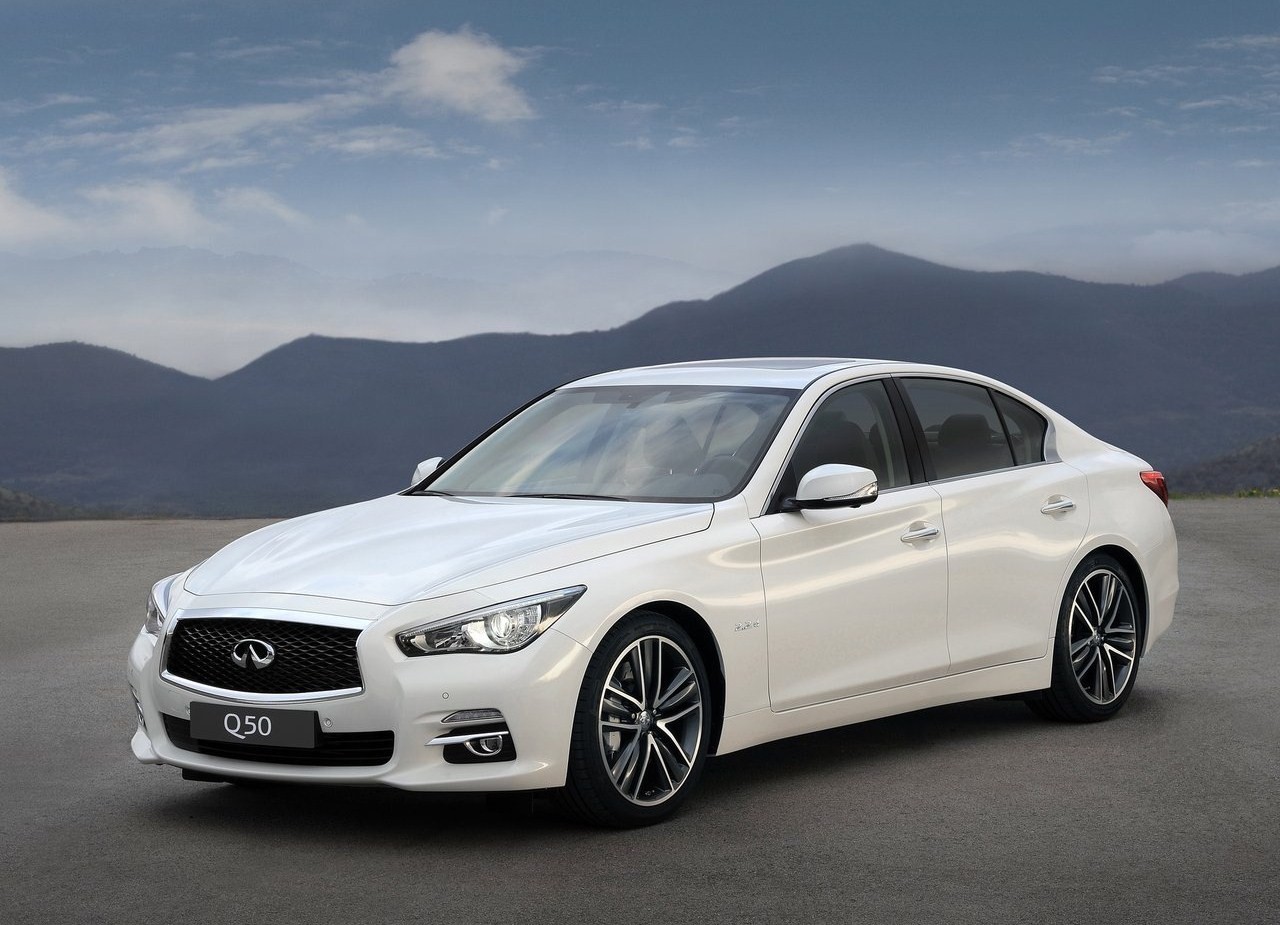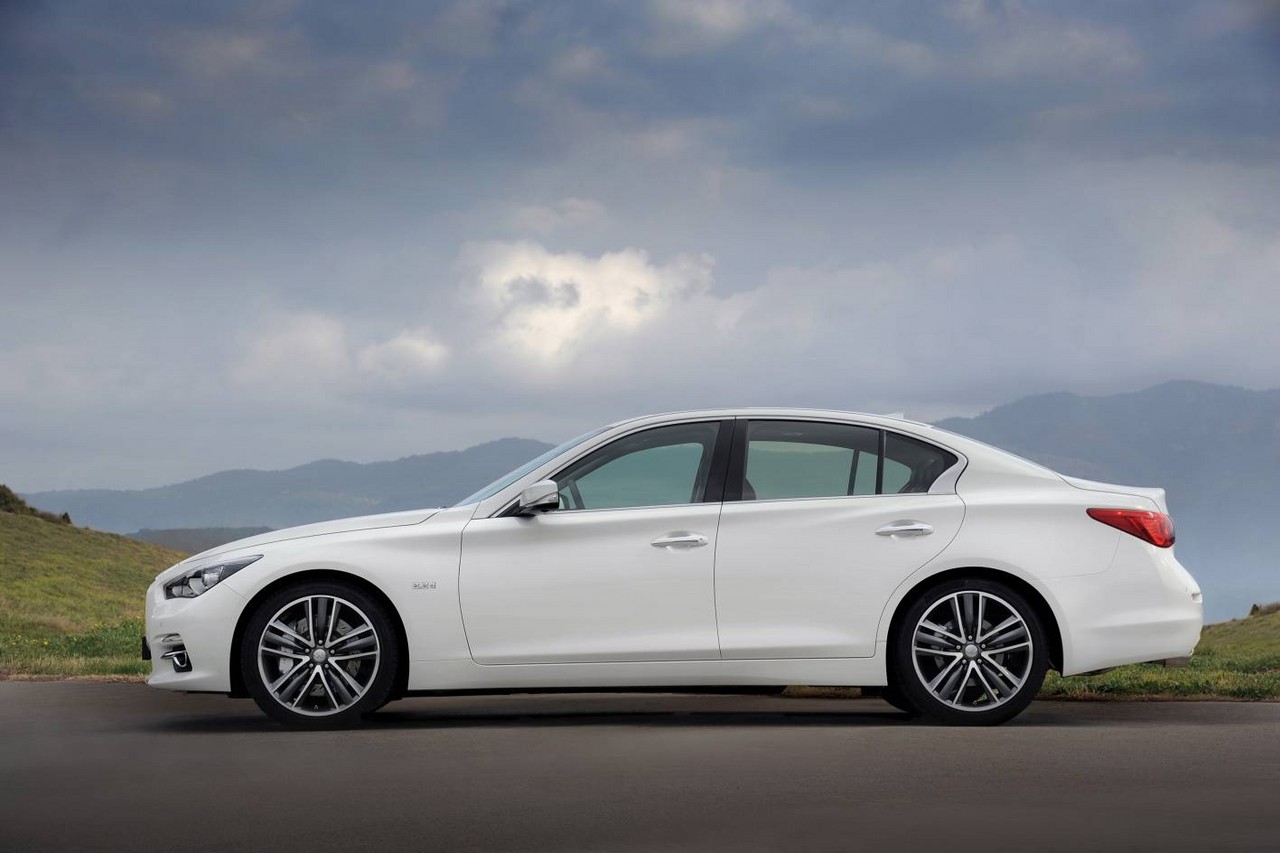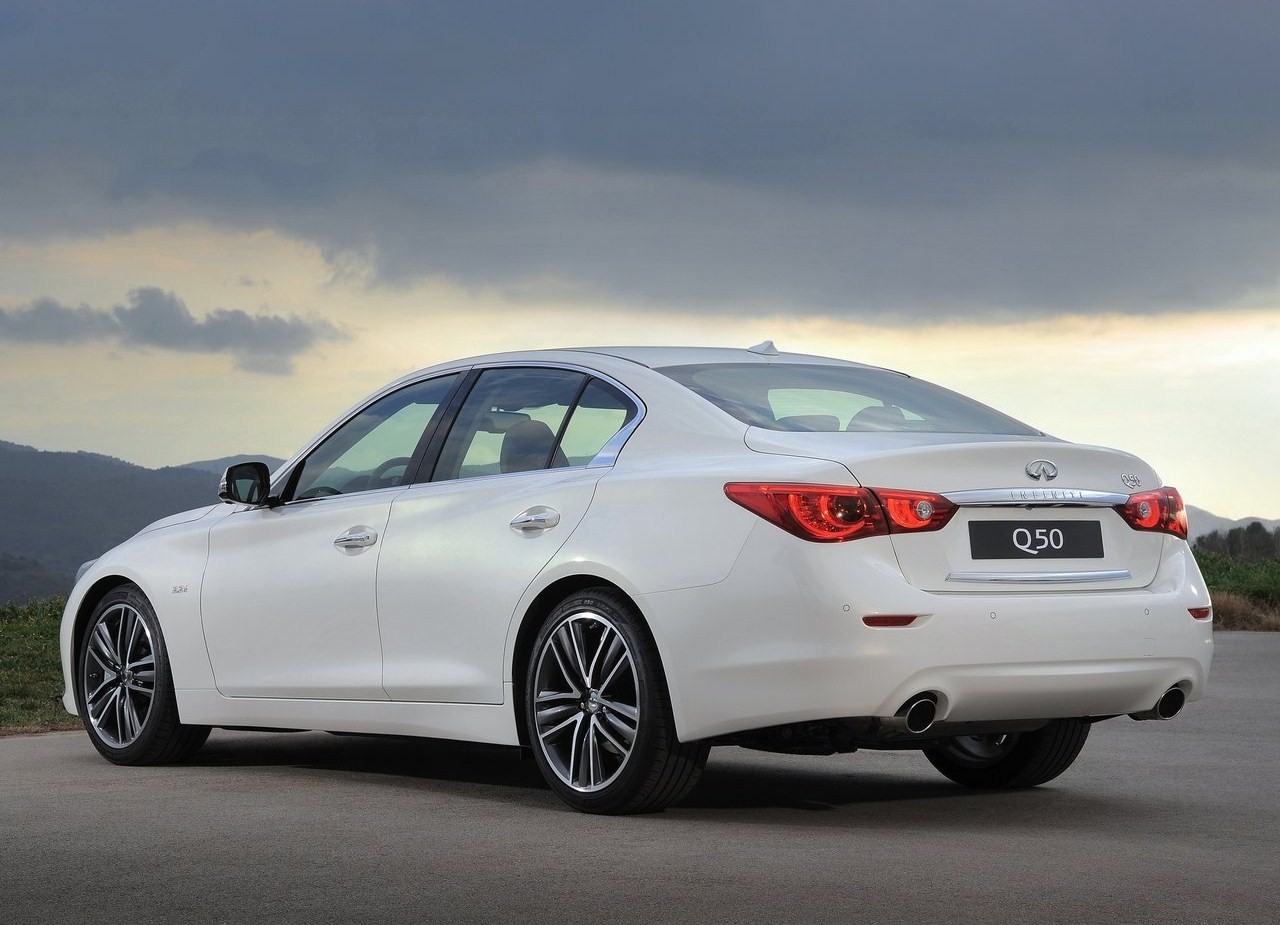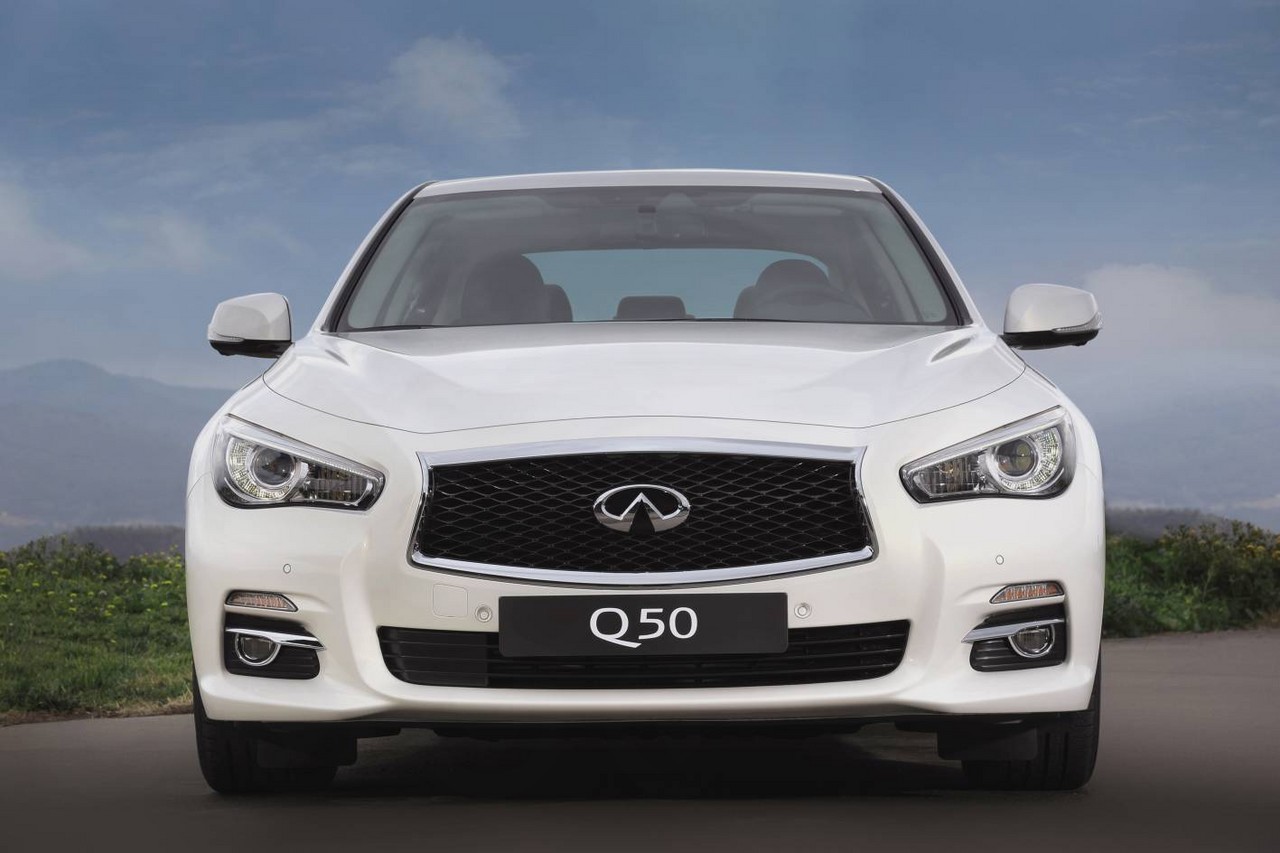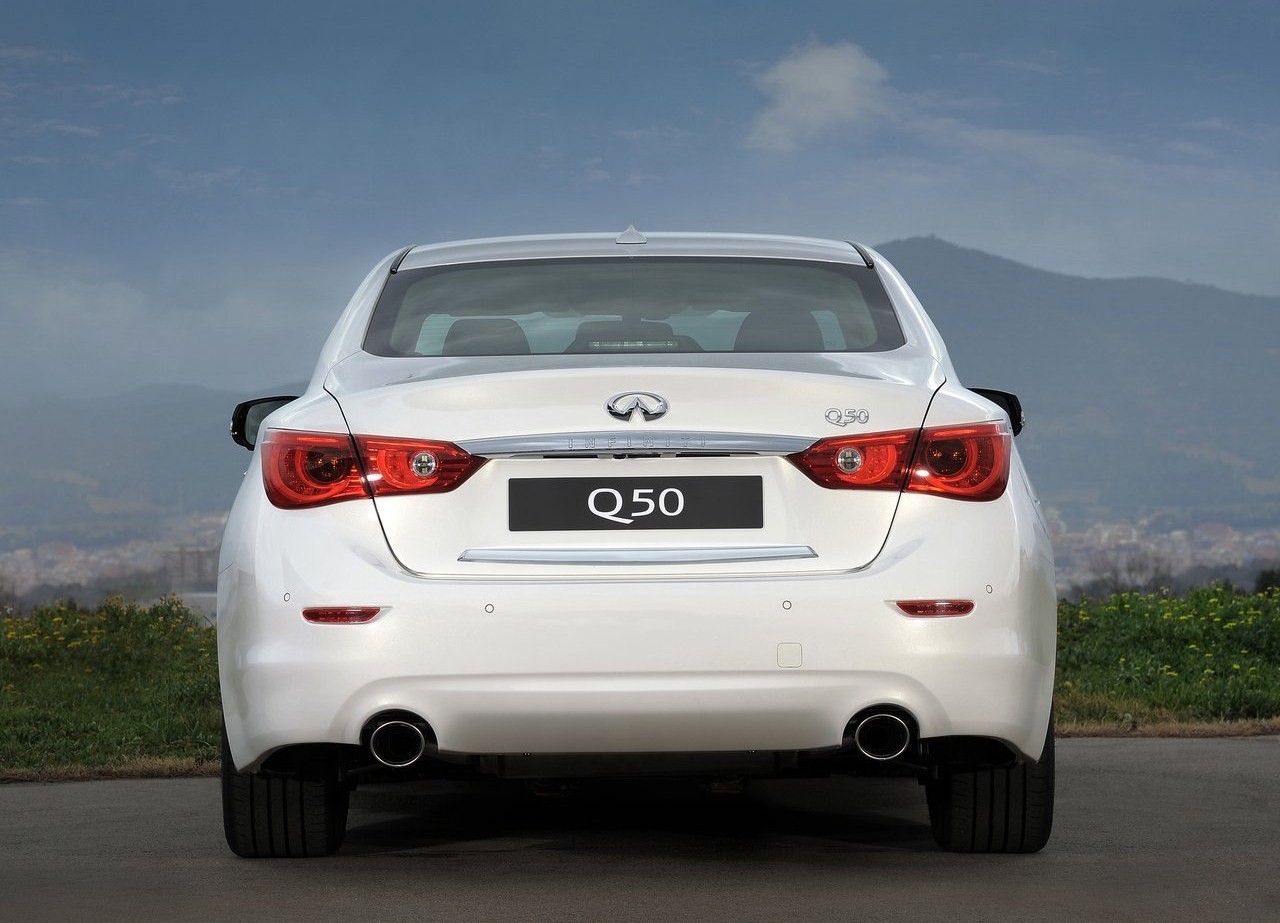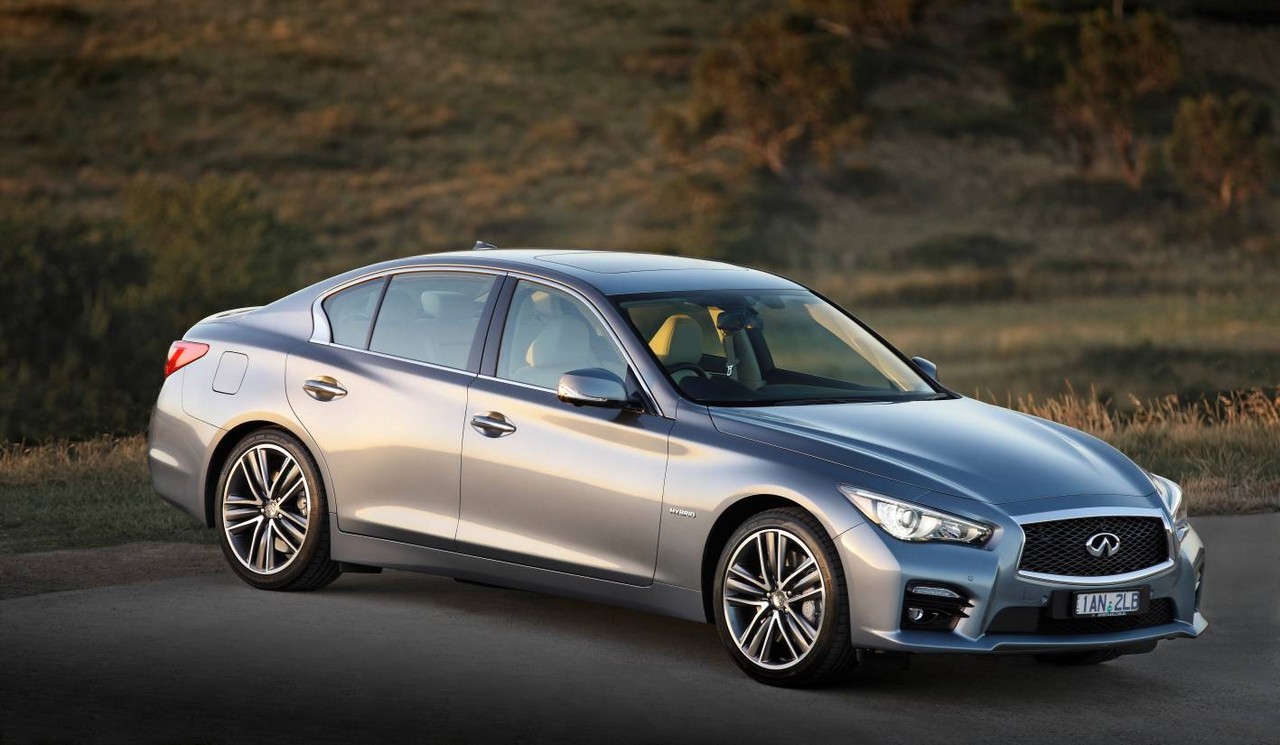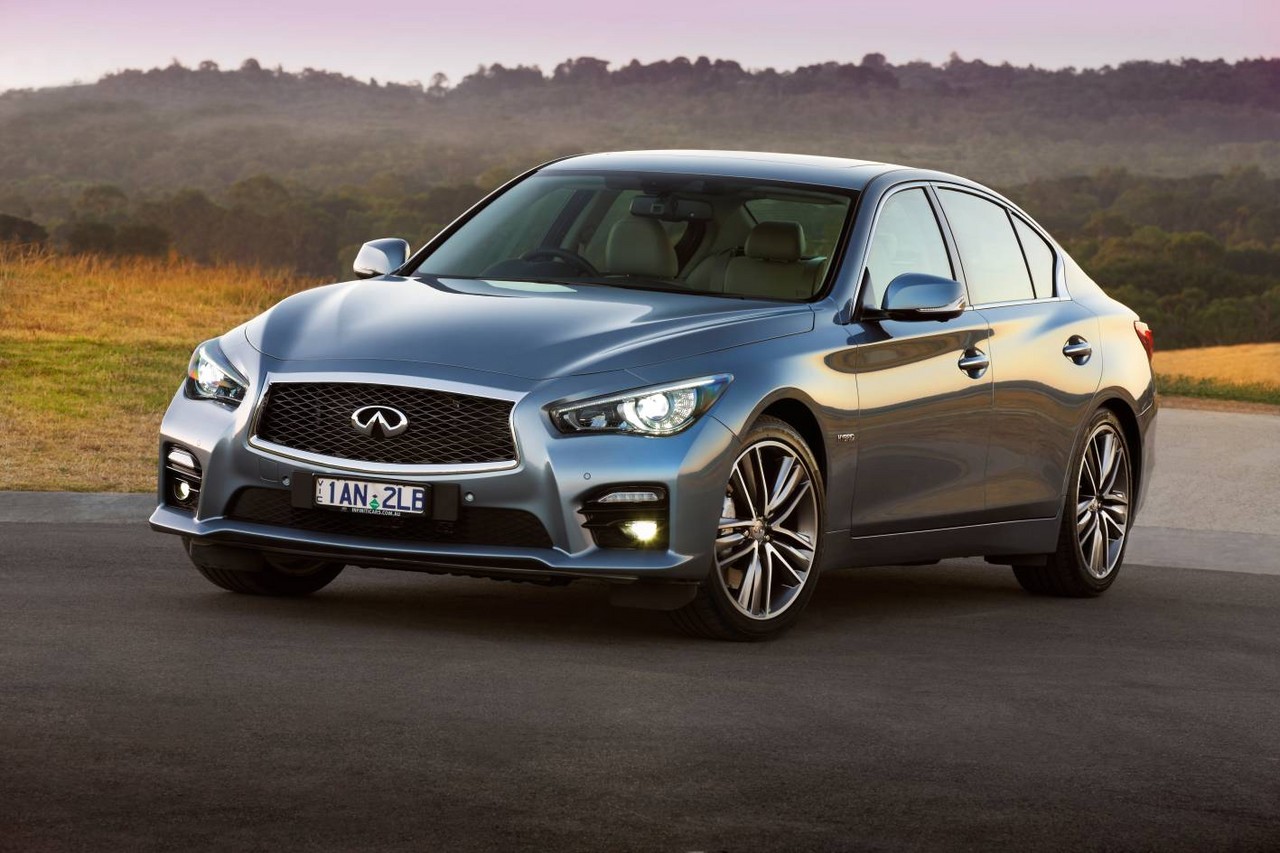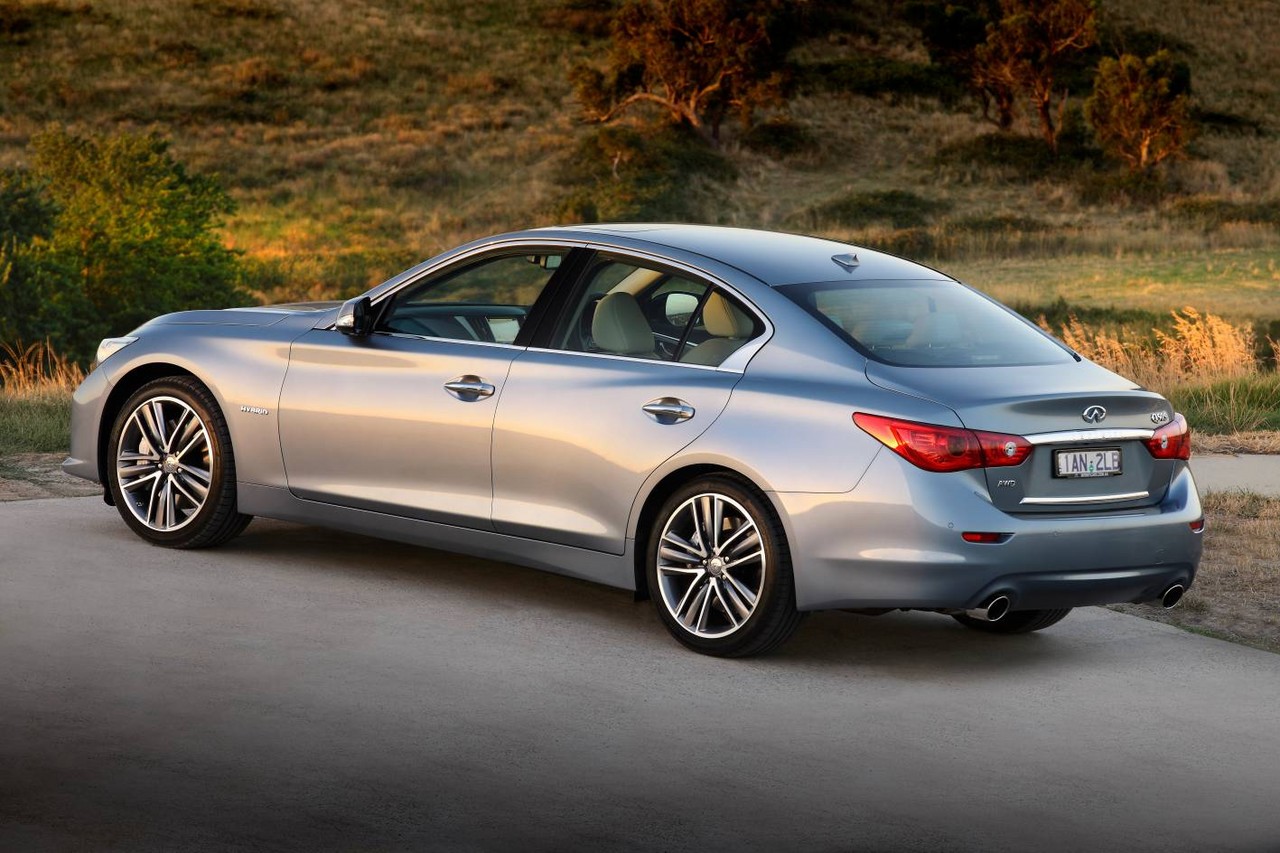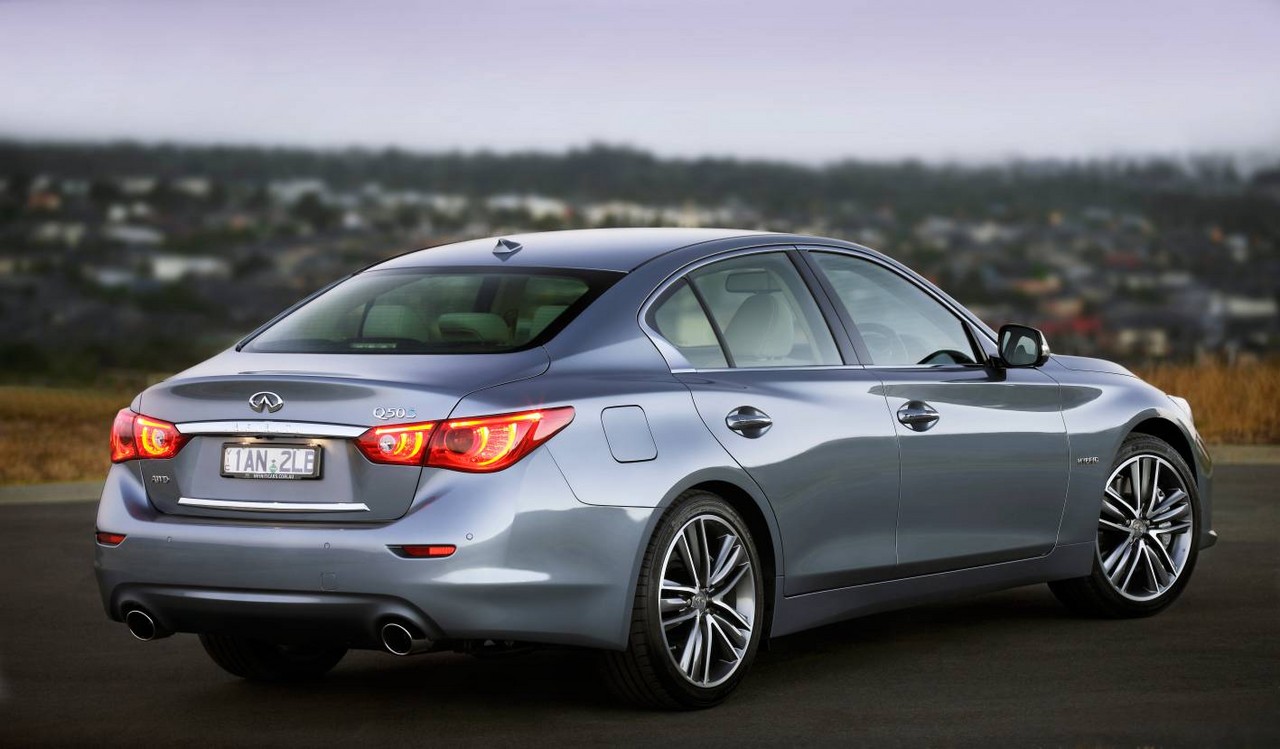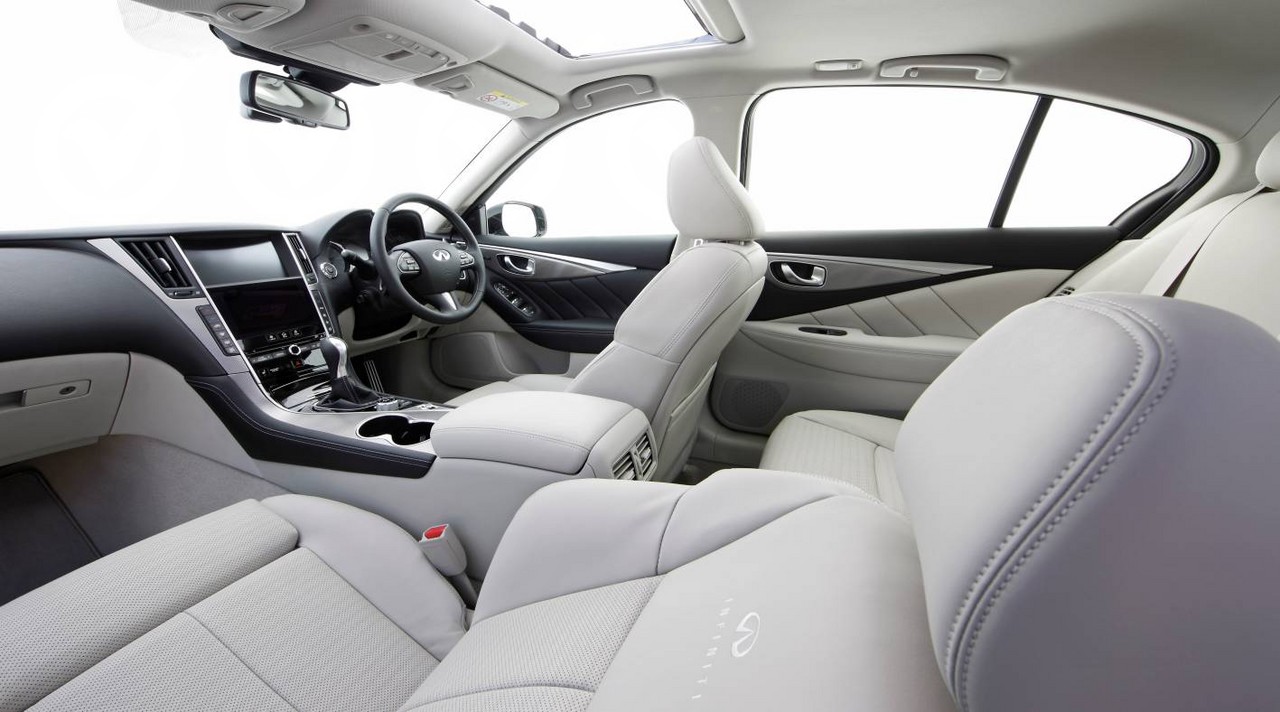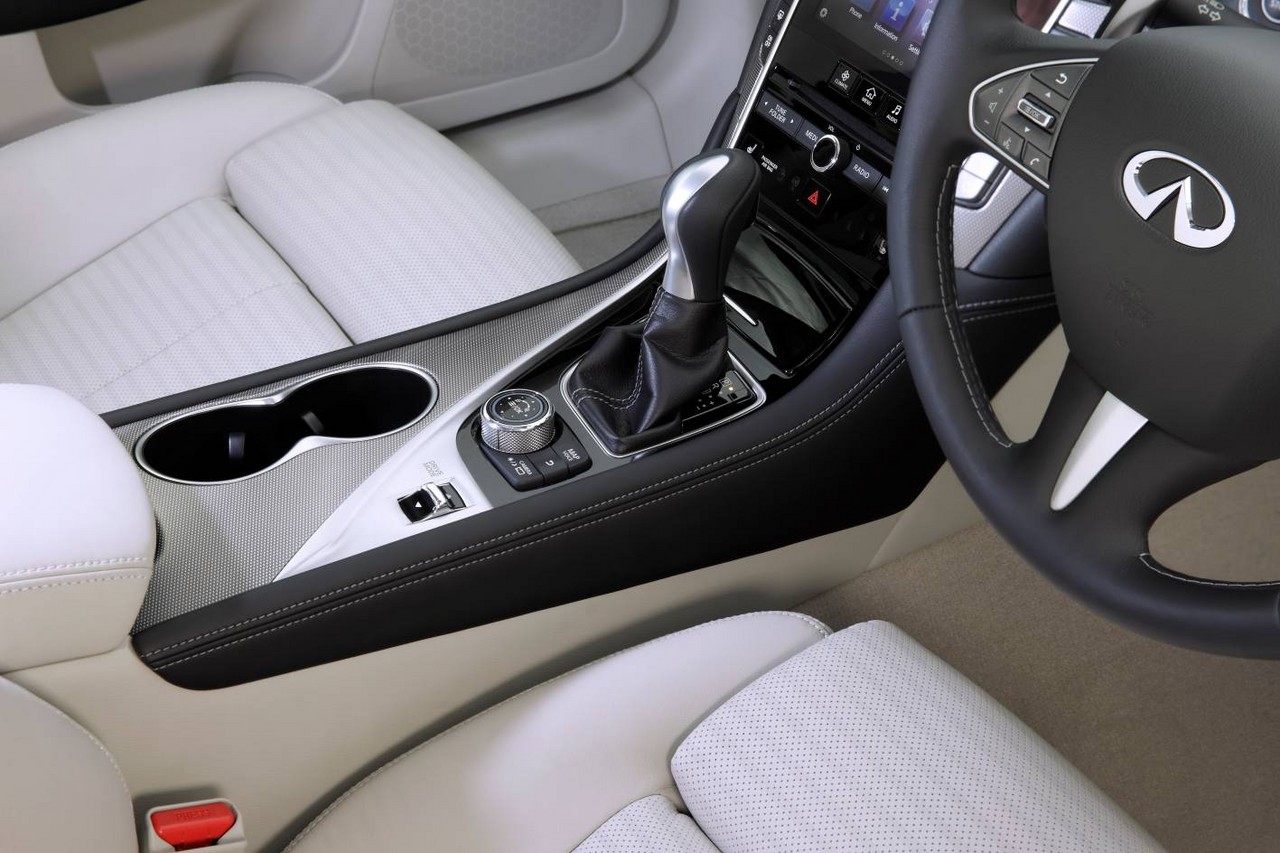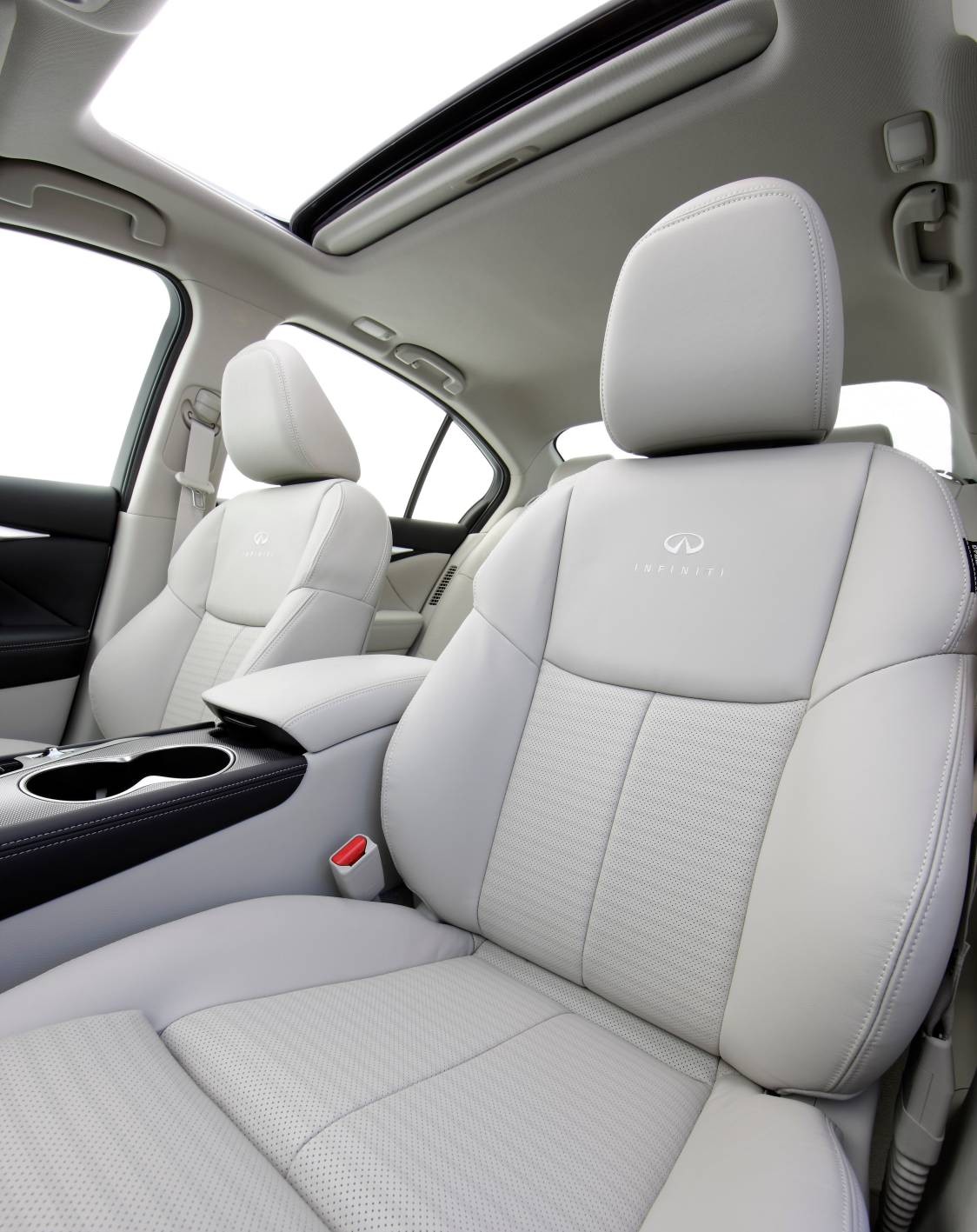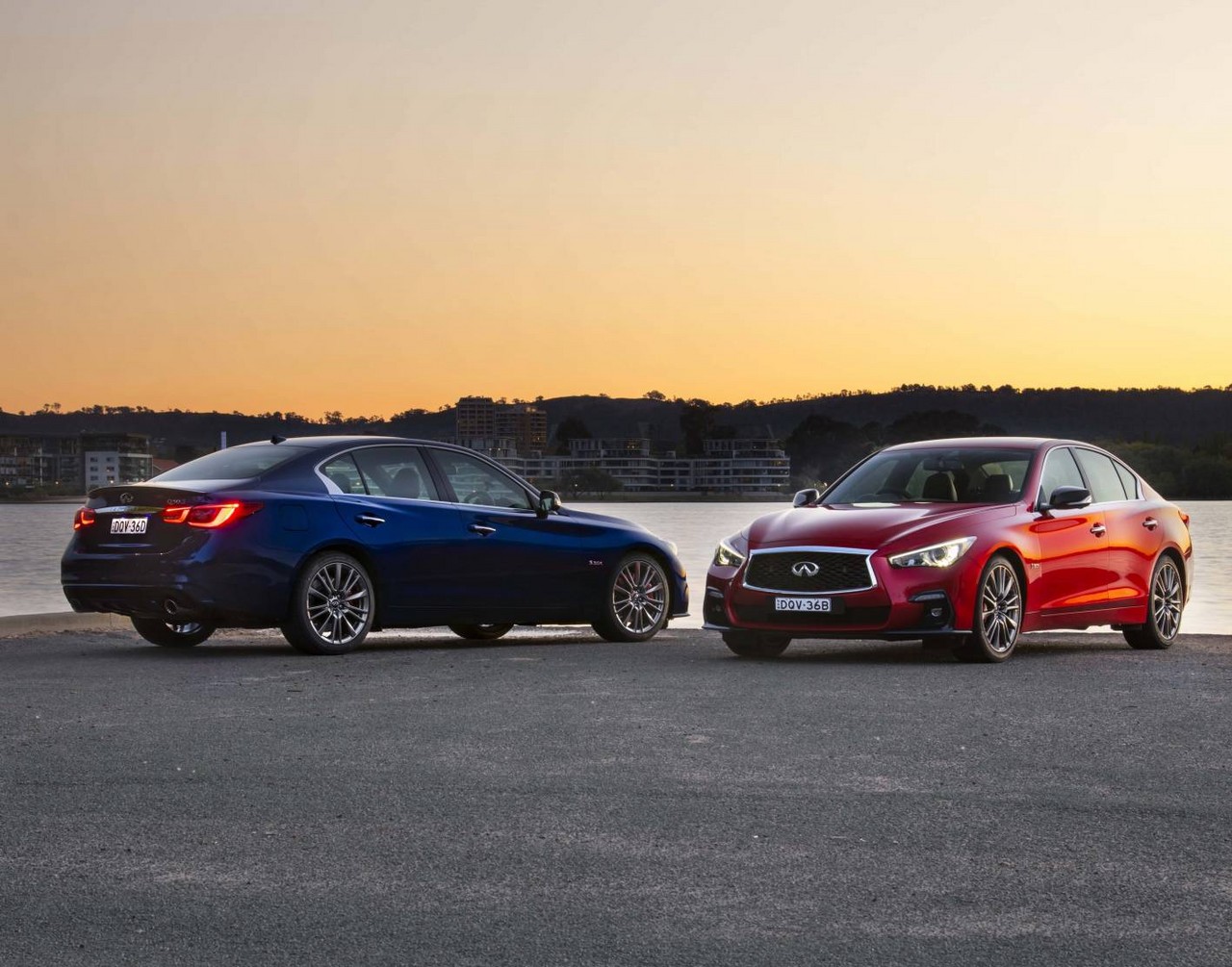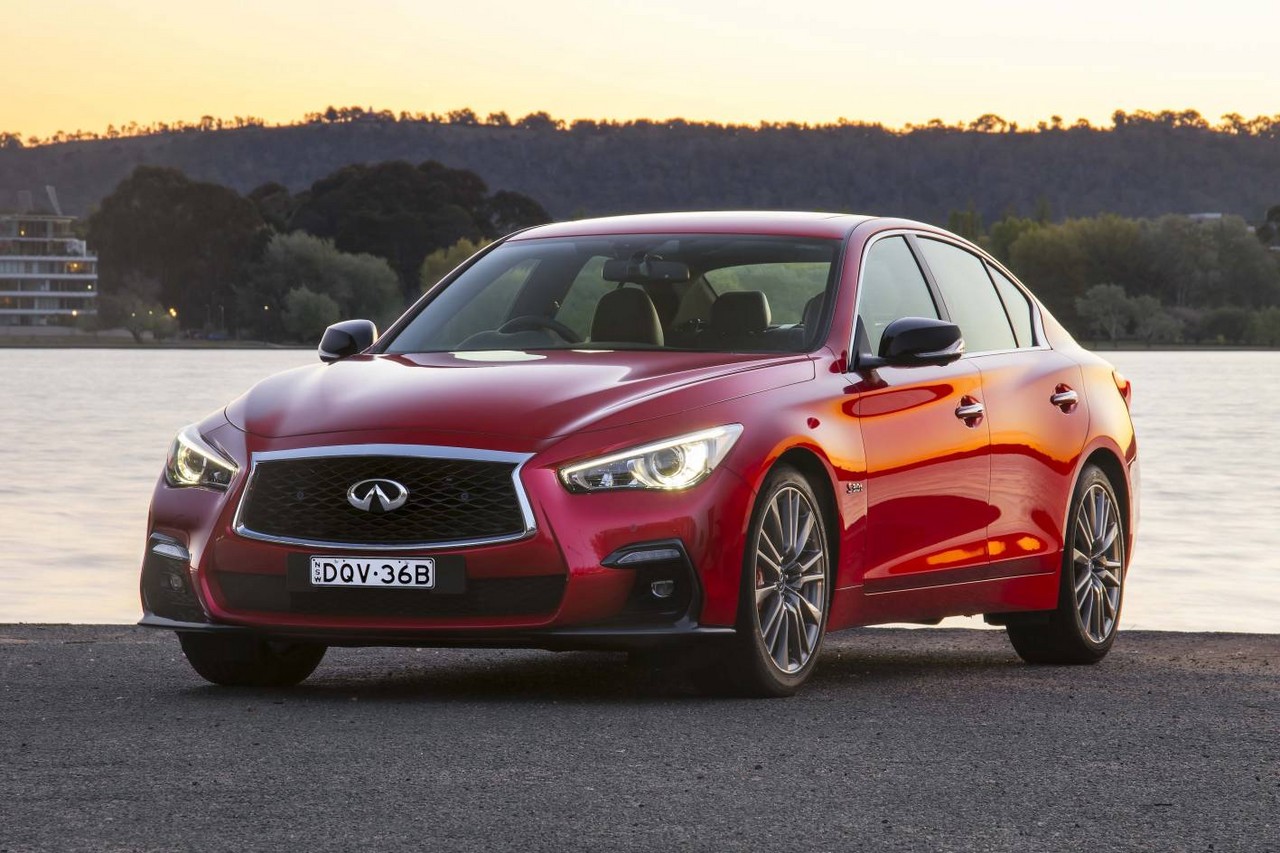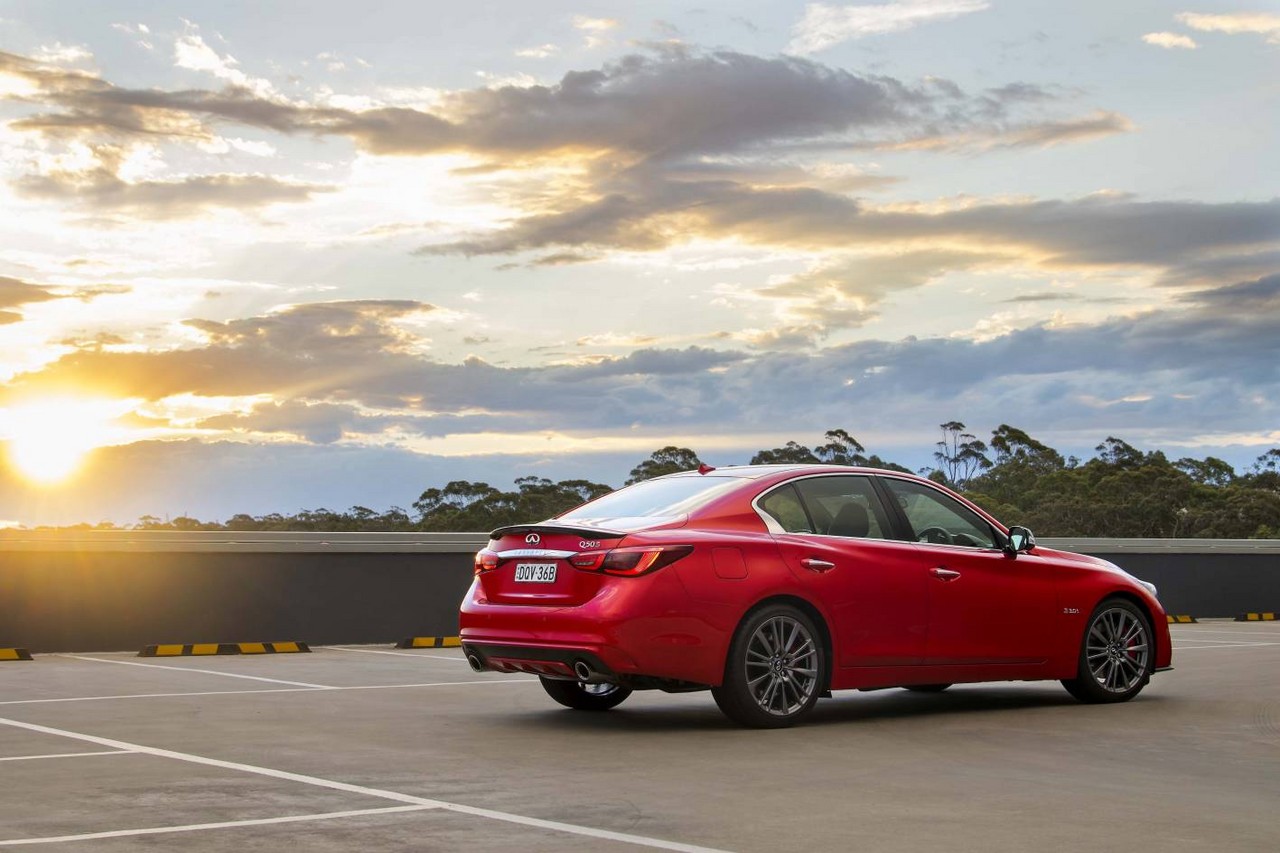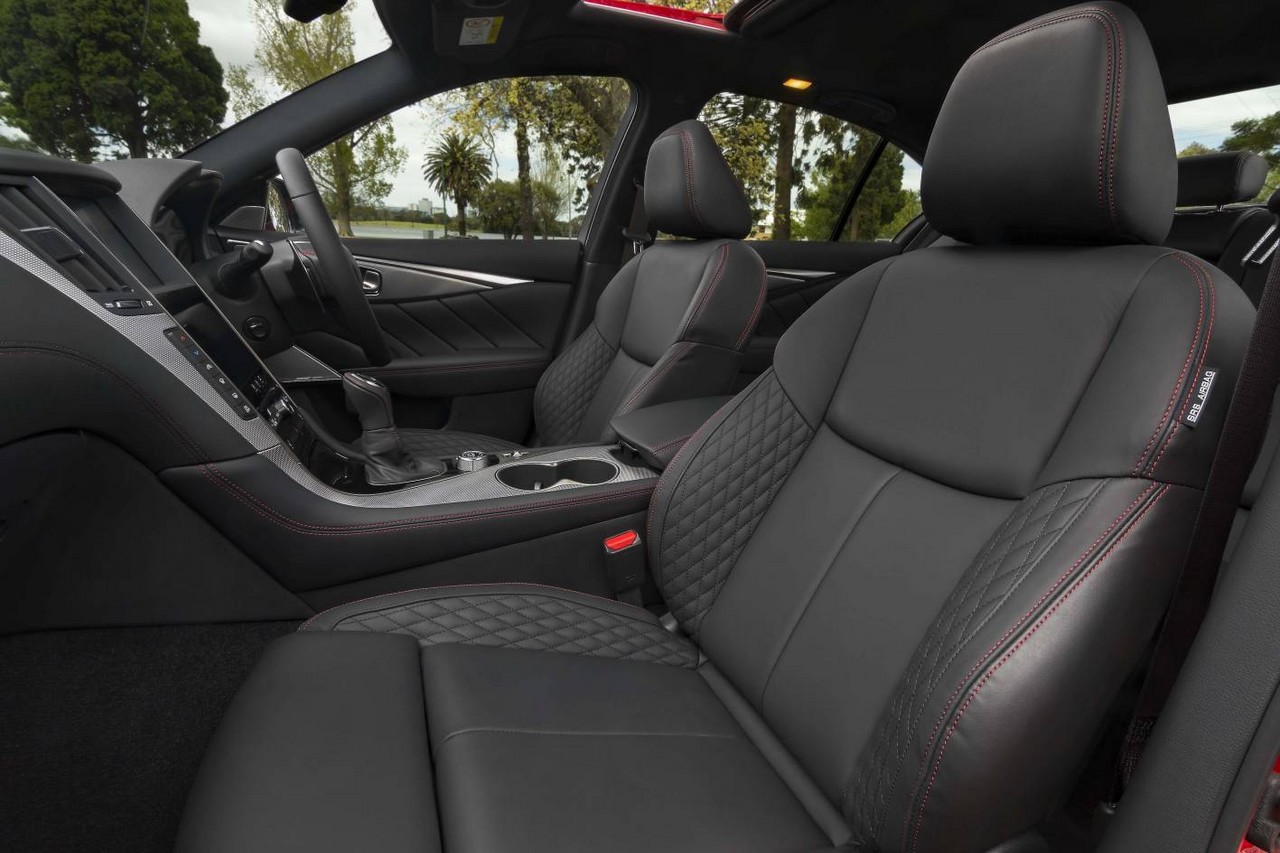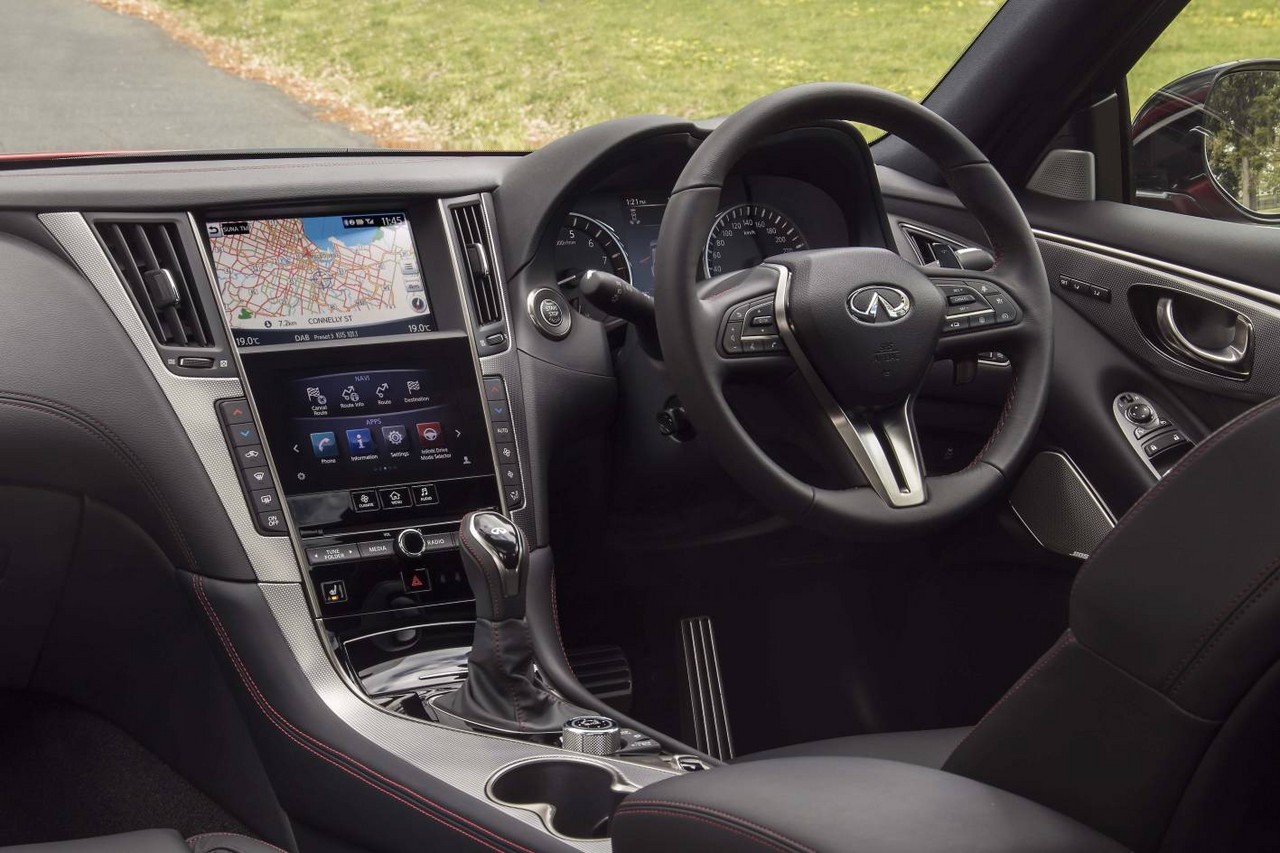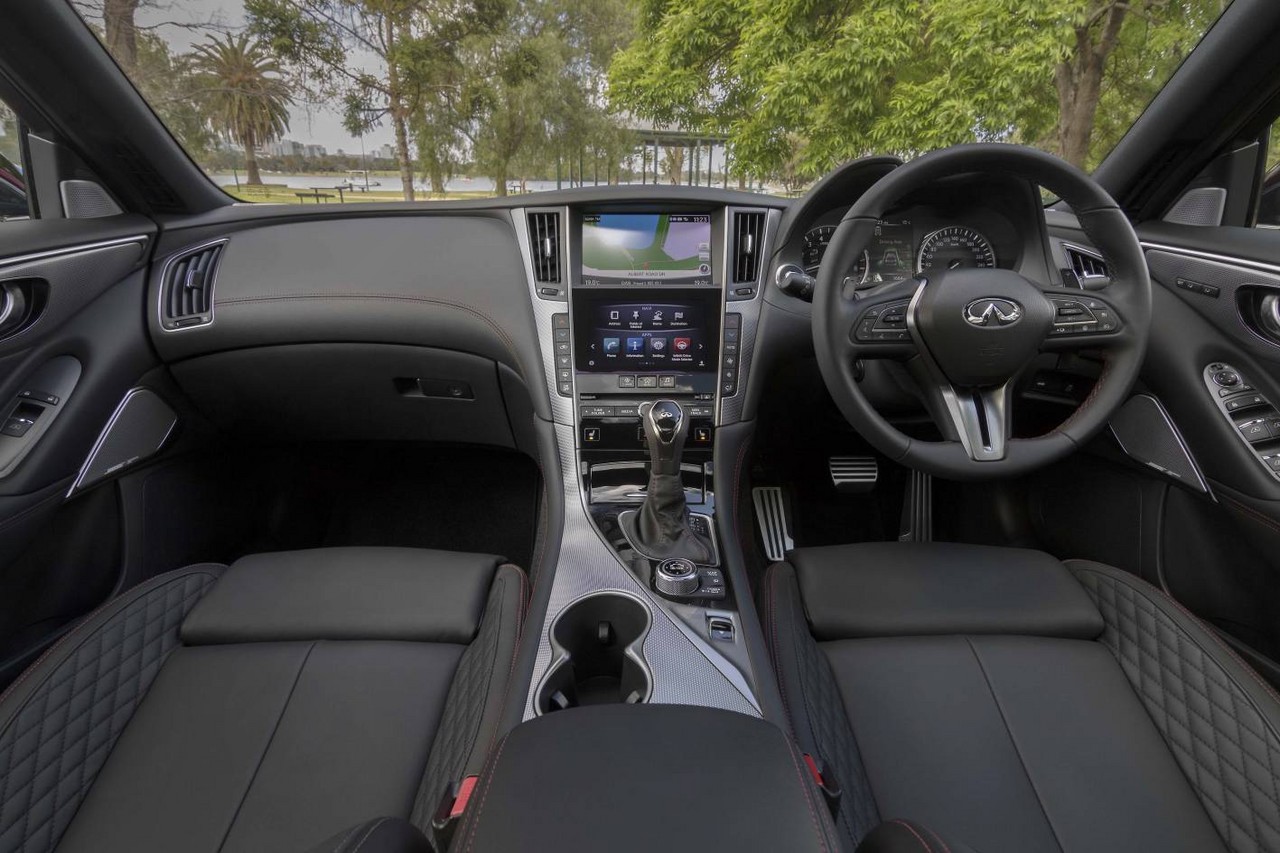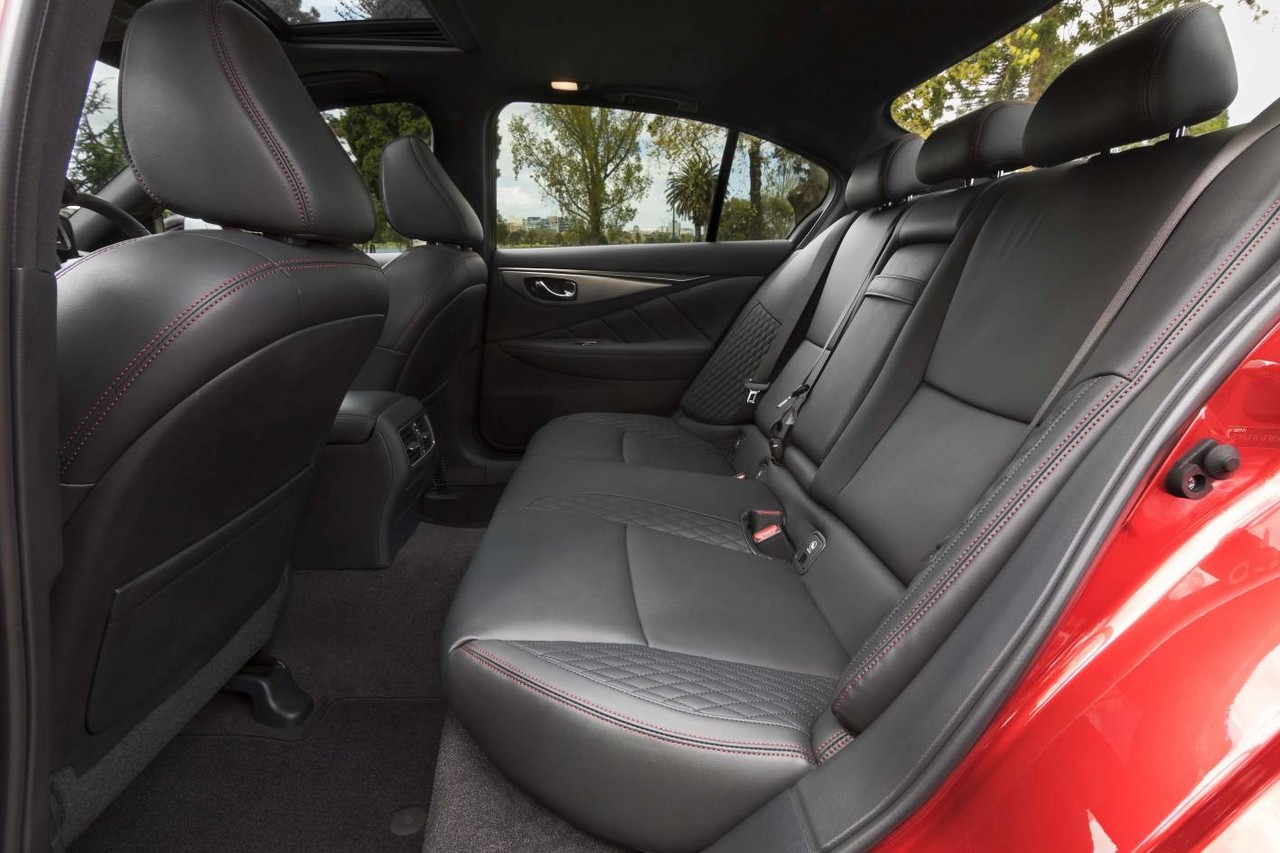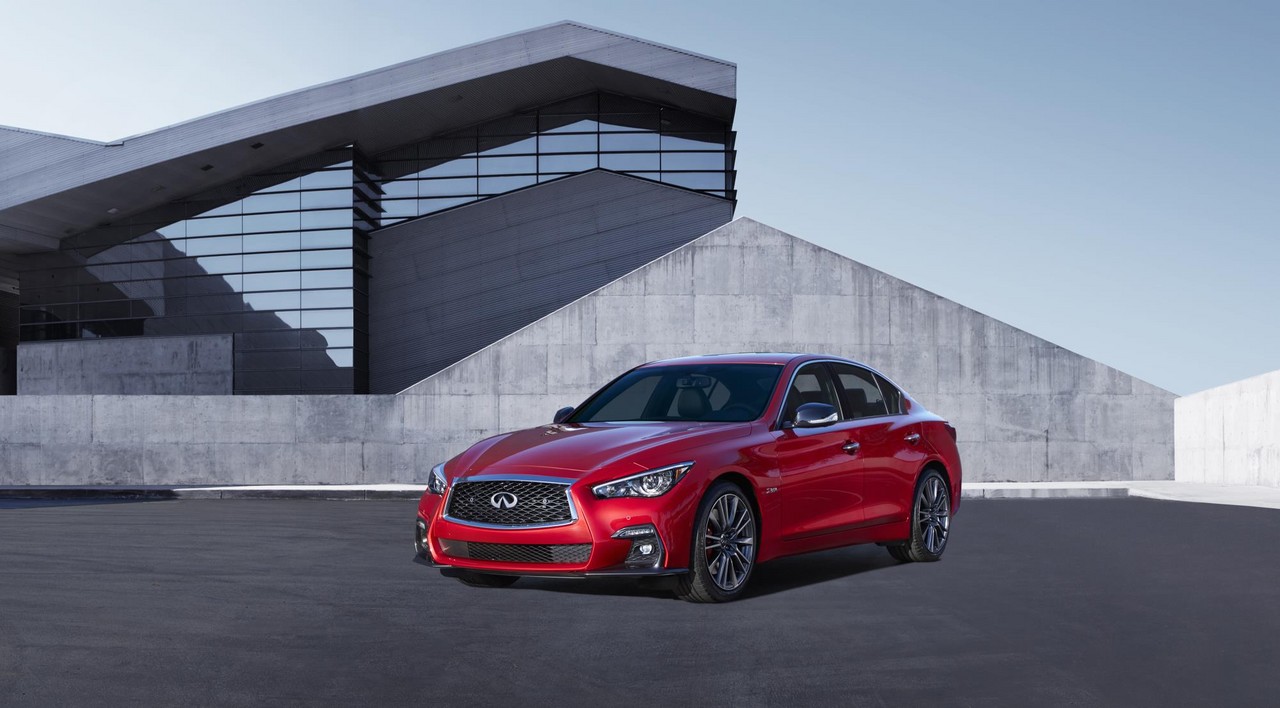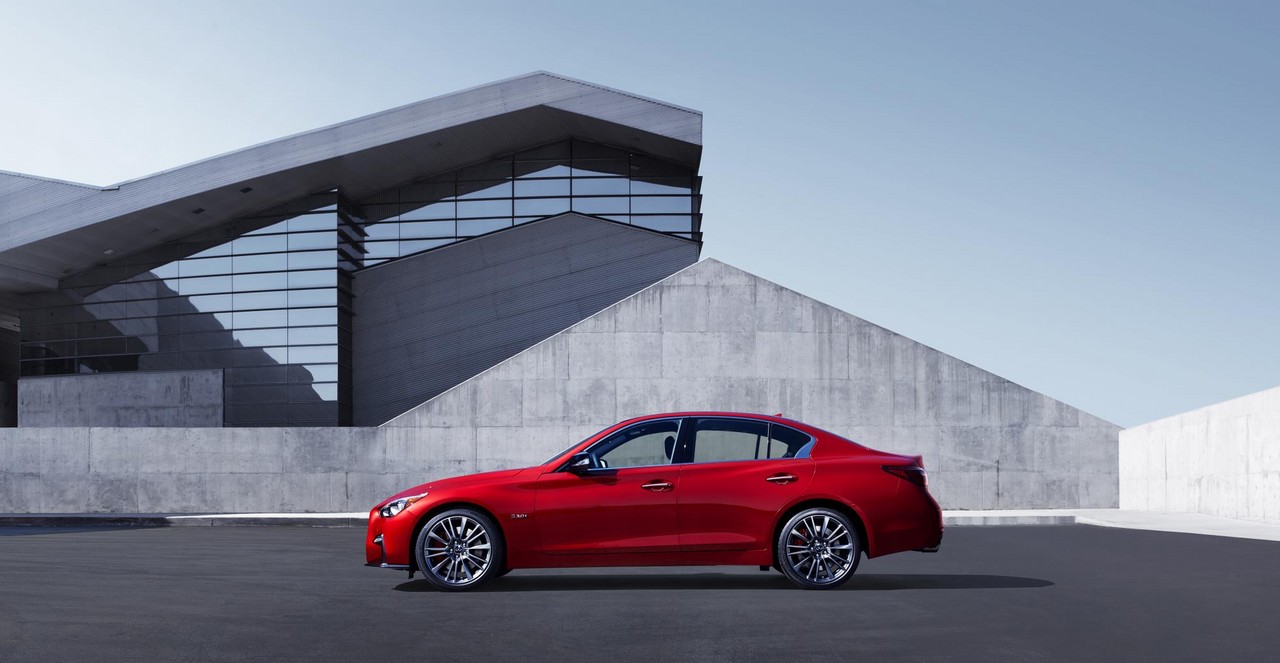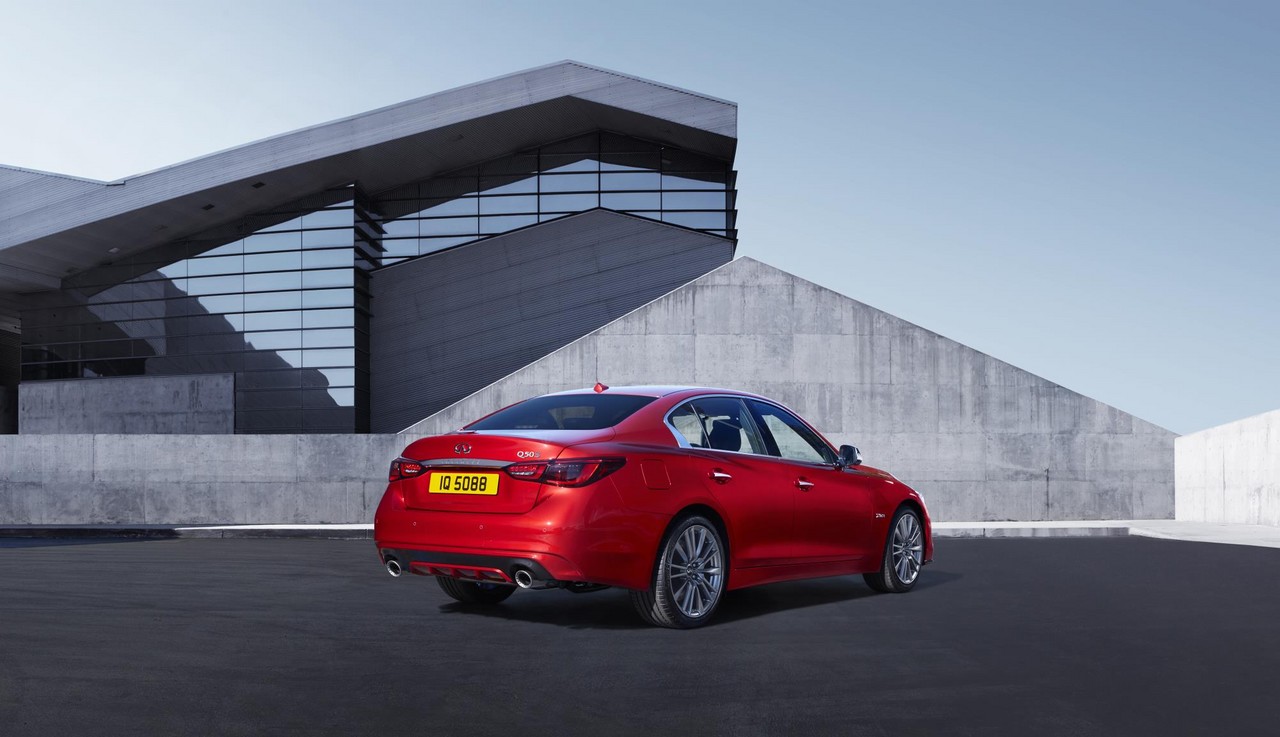
- Supportive front seats
- Responsive hybrid powertrain
- Cramped rear seats
- Run-flat tyres contribute to firm ride
- Lag from 2.1-litre turbo-diesel engine
- Inconsistently weighted steering
Review: Infiniti V37.I Q50 (2014-17)
Overview
Released in February 2014, the Infiniti V37 Series I (V37.I) Q50 was a mid-size sedan. Manufactured in Tochigi, Japan, the V37 Q50 was initially available with either a 2.2-litre turbo-diesel engine or a hybrid powertrain which consisted of a 3.5-litre V6 petrol engine and a 50 kW electric motor. Subsequently, however,
- 2.0-litre turbocharged petrol engines were introduced in September 2014; and,
- 3.0-litre biturbo V6 petrol engines were introduced in September 2016.
Drivetrains
Of the engines,
- For the Q50 2.2d, the 2.1-litre Mercedes-Benz OM651 turbo-diesel engine had a cast iron block, an aluminium cylinder head, double overhead camshafts, common-rail direct injection, four valves per cylinder and a compression ratio of 16.2:1. The engine also had ‘start-stop’ technology which enabled it to shut down when the vehicle was stationary in traffic and quickly restart when the driver’s foot was lifted from the brake pedal;
- Shared with the M35h sedan , the hybrid powetrain for the Q50 Hybrid combined Nissan’s 3.5-litre VQ35HR V6 petrol engine – operating on an Atkinson cycle – with a 50 kW electric motor that drew power from a lithium-ion battery pack that was located behind the rear seats. The hybrid system also had twin clutch motor control which enabled the V6 engine to be decoupled from the drivetrain when the car was in its electric drive and power regeneration modes;
- For the Q50 2.0t, the 2.0-litre Mercedes-Benz M274 petrol engine had a cast iron block, an aluminium cylinder head, a single IHI (ICSI) turbocharger, direct fuel injection, a hollow crankshaft, double overhead camshafts (chain-driven), variable camshaft timing, four valves per cylinder and a compression ratio 9.8:1. Like the OM651 engine, the M274 engine also had a start-stop function; and,
- For the Q50 3.0tt, the 3.0-litre VR30DDTT biturbo V6 petrol engine had an aluminium alloy block with an arc sprayed mirror coating for the bores, an aluminium alloy cylinder head with integrated exhaust manifold, double overhead camshafts, four valves per cylinder, variable intake and exhaust valve timing (electronically and hydraulically controlled, respectively), direct fuel injection, water-to-air intercoolers and electronic wastegate actuators. For the 224 kW VR30DDT engine, peak boot pressure was 9.5 psi; for the 298 kW VR30DDT engine, a turbine speed sensor was fitted and peak boost pressure was 14.7 psi.
All engines were mated to seven-speed automatic transmissions which had sequential gearshift functions.
| Variant | Edition | Drive | Motor | Peak power | Peak torque | Trans. |
|---|---|---|---|---|---|---|
| 2.0t | GT, S, S Premium |
RWD | 2.0-litre M274 turbo petrol I4 | 155 kW at 5500 rpm | 350 Nm at 1500-3500 rpm | 7sp auto |
| 2.2d | GT, S, S Premium |
RWD | 2.1-litre OM651 turbo-diesel I4 | 125 kW at 3200-4200 rpm | 400 Nm at 1600-2800 rpm | 7sp auto |
| Hybrid | S | RWD | 3.5-litre petrol V6 | 219 kW at 6800 rpm | 350 Nm at 4800 rpm | 7sp auto |
| Electric motor | 50 kW at 1770-2000 rpm | 270 Nm at 1770 rpm | ||||
| Combined | 268 kW at 6500 rpm | 546 Nm at 1470 rpm | ||||
| S Premium | AWD | 3.5-litre petrol V6 | 219 kW at 6800 rpm | 350 Nm at 4800 rpm | 7sp auto | |
| Electric motor | 50 kW at 1770-2000 rpm | 270 Nm at 1770 rpm | ||||
| Combined | 268 kW at 6500 rpm | 546 Nm at 1470 rpm | ||||
| 3.0tt | S Premium | RWD | 3.0-litre VR30DDTT biturbo petrol V6 | 224 kW at 6400 rpm | 400 Nm at 1600-5200 rpm | 7sp auto |
| Red Sport | RWD | 3.0-litre VR30DDTT biturbo petrol V6 | 298 kW at 6400 rpm | 475 Nm at 1600-5200 rpm | 7sp auto |
Dimensions
The Infiniti Q50 was 4783 mm long, 1824 mm wide, 1443 mm tall and had a 2850 mm long wheelbase; its drag coefficient was 0.26 Cd. While standard Infiniti Q50 models had a boot capacity of 500 litres, this was reduced to 400 litres for the Infiniti Q50 Hybrid.
Suspension
The Infiniti Q50 had single pivot, double-wishbone front suspension and independent, multi-link rear suspension with coil springs. While the standard Infiniti Q50 models had ‘Dual Flow Path’ shock absorbers,
- The Infiniti Q50 Hybrid had double piston shock absorbers; and,
- The Infiniti Q50 3.0tt variants had ‘Dynamic Digital Suspension’ which consisted of electronically-controlled shock absorbers with three drive modes: Standard, Sport and Sport+.
According to Infiniti, revised suspension settings were introduced in September 2016 to ‘provide an improved balance between confident handling and a comfortable ride’.
Direct Adaptive Steering
As standard, the Infiniti Q50 has rack-and-pinion steering with electric power assistance. Beyond this, the Q50 S and S Premium editions were fitted with Infiniti’s ‘Direct Adaptive Steering’ (DAS), an electronic steer-by-wire system. With DAS, the driver’s steering wheel inputs were electronically transferred to the front wheels by a high-response actuator which drives the steering rack. By eliminating mechanical losses that can slow the responses in conventional systems, steering response was faster and steering wheel vibrations were eliminated. Furthermore, the driver had the ability to adjust both steering weight and response (gearing) via a touch screen as part of the ‘Infiniti Drive Mode Selector’. DAS included a triple-mode back-up (three separate electronic control units) and a mechanical steering linkage as a failsafe.
From September 2016, the Infiniti Q50 was equipped with the second generation Direct Adaptive Steering (DAS) system which had revised control logic to provide greater steering feel and feedback. The upgraded system also provided additional options to adjust response and feel.
Safety equipment
Standard safety equipment for the Infiniti Q50 included dual front airbags, front side airbags, full-length curtain airbags, ABS, electronic brake force distribution, brake assist, electronic stability control, traction control, active front seat head restraints and front seatbelts with pre-tensioners and load limiters.
The Q50 S editions were also equipped with Active Lane Control (ALC). Using a camera in front of the rearview mirror, this system detects lane markers and applies small steering force and angle adjustments to help the driver maintain a straight path.
Beyond this, Q50 S Premium editions were further equipped with:
- Intelligent Cruise Control (ICC): enabled the driver to specify the desired speed and distance to the vehicle ahead. If the vehicle ahead slowed, ICC would automatically brake the vehicle to maintain the distance and resume the desired cruising speed when the vehicle ahead accelerated;
- Distance Control Assist (DCA): detected if the vehicle ahead was braking and provided feedback through the accelerator pedal to instruct the driver to remove their foot from the pedal;
- Predictive Forward Collision Warning (FCW) and Forward Emergency Braking systems: used a radar sensor located behind the front bumper to alert the driver when there was a potential risk of a forward collision. When this occurred, a warning tone would sound and the ‘Vehicle Ahead Detection’ indicator light would illuminate. If active, the Forward Emergency Braking system would apply upward pressure on the accelerator pedal to alert the driver and provide partial braking. If the driver did not respond, additional audible and visual warnings were given and increased braking force applied;
- Lane Departure Warning (LDW) and Lane Departure Prevention (LDP): a camera mounted near the rear view mirror would detect lane markers and whether the vehicle was drifting into another lane without indicating. A warning tone would initially sound, followed by autonomous braking of the wheels on the opposing side of the vehicle if the vehicle continued to drift;
- Blind Spot Warning (BSW) and Blind Spot Intervention (BSI): provided visual and audible warnings if another vehicle was detected in the blind-spot area (BSW). If the driver ignored the warning and attempted to steer into the other vehicle’s path, the brakes would be automatically applied on the opposing side of the vehicle to return the vehicle to its lane (BSI);
- Back-up Collision Intervention (BCI): could detect stationary objects and crossing traffic behind the vehicle and warn the driver via an audible tone and flashing light. If the driver failed to respond, the system would apply upward pressure on the accelerator pedal and momentarily apply the brakes to alert the driver;
- Around View Monitor (AVM) with Moving Object Detection (MOD): AVM was a parking aid which provided a virtual video image of the vehicle with surrounding objects, including moving objects; and,
- Active Front-lighting System (AFS) with High Beam Assist: included self-leveling headlights and, when travelling at speeds of 35 km/h and above, automatically turned off the high beams in the presence of oncoming traffic.
From September 2016, the Infiniti Q50 GT was equipped with:
- Around View Monitor (AVM) with Moving Object Detection (MOD);
- Active Front-lighting System (AFS) with High Beam Assist: and,
- Lane Departure Prevention (LDP).
Brakes
The standard braking package for the Infiniti Q50 consisted of 320 mm ventilated front brake discs with two-piston calipers and 308 mm ventilated rear discs with single piston calipers.
The Infiniti Q50 Hybrid and Q50 3.0tt, however, had 355 mm ventilated front brake discs with four-piston calipers and 350 mm ventilated rear disc brakes with two-piston calipers.
Euro NCAP testing
In Euro NCAP testing , the Infiniti Q50 2.2d received a five star safety rating which included an 86 per cent adult occupant protection rating and an 85 per cent child occupant protection rating. In the offset crash test, occupant protection was generally assessed as good, although chest protection for both the driver and front passenger was rated as adequate. In the side impact test, protection of the driver’s chest and pelvis was only rated as adequate and, in the more severe pole test, chest protection was assessed as marginal.
Based on the Euro NCAP testing, rear-wheel drive Infiniti Q50 models received a five star adult occupant protection rating from ANCAP with a score of 35.76 out of 37.
Features: Infiniti Q50 GT
Standard features for the Infiniti Q50 GT included 17-inch alloy wheels with 225/55 R17 97W run-flat tyres, digital radio (DAB+), Infiniti InTouch dual touch-screen displays, satellite navigation system with Traffic Messaging Channel (TMC), climate control air conditioning, leather upholstery, power adjustable front seats, cruise control, LED headlights, daytime running lights, Bluetooth 3.0 audio streaming and mobile phone connectivity, remote central locking with proximity key, power windows and mirrors, a height and reach adjustable steering wheel, driver memory settings, tyre pressure monitoring and an immobiliser.
As standard, the Infiniti Q50 also featured an ‘Active Noise Control’ function as standard which used four door-mounted speakers to cancel intrusive low frequency and an ‘i-Key’ system which could recognise different drivers and select from up to four separate profiles for driving position, heating and cooling, audio, navigation and telematics settings.
Features: Infiniti Q50 S and S Premium
The Q50 S was further equipped with 18-inch alloy wheels with 225/50 95W tyres, a fourteen speaker ‘Studio on Wheels’ Bose sound system, magnesium-modified gearshift paddles, a power sunroof with sliding sunshade and sports front bumper. The Q50 Hybrid S editions, however, were fitted 19-inch alloy wheels, sports suspension and a regenerative braking system.
For the Q50 S Premium, 19-inch alloy wheels and 245/40 R19 94W tyres were fitted as standard.
Features: Infiniti Q50 Red Sport
Compared to the Infiniti Q50 S Premium, the Q50 Red Sport could be identified by its black boot spoiler.
Brochure
Related links
Review: Infiniti V37.II Q50 (2017-19)
Overview
The Infiniti V37 Series II (V37.II) Q50 was released in Australia in October 2017. The V37.II Q50 range was simplified as the 2.2d variants and S editions were discontinued, while the ‘S Premium’ editions were renamed ‘Sport Premium’.
In August 2018, however, the Infiniti V37.II Q50 range was revised and the edition names were changed as follows –
- Pure (previously GT);
- Sport (previously Sports Premium);
- Blue Sport (previously the hybrid Sports Premium); and,
- Red Sport (unchanged).
Retail prices were also reduced at this time.
Styling
Visually, the Infiniti V37.II Q50 could be identified by its double-arch grille which had deeper detailing of the waved mesh-pattern surface and chrome surround, revised LED headlamps which enhanced ‘Infiniti’s trademark ‘human-eye’ aspect’ and slimmer LED rear combination lamps that were derived from the Q60 Coupe.
The V37.II Q50 Sport Premium and Red Sport editions were further differentiated by their more angular front bumpers, wider and lower front air intakes and more prominent aerofoil at the base of the front bumper. Unique within the range, the V37.II Q50 Red Sport had thin-spoke 19-inch alloy wheels, high-gloss black paint finishes for its door mirrors, a two-tone paint finish for its rear diffuser and dark metallic trim at the base of its rear bumper.
Interior
Inside, the Infiniti V37.II Q50 featured two touch-capacitive colour screens – an eight-inch upper screen and a seven-inch lower screen – for Infiniti’s ‘InTouch Services’ in-car connectivity system. Other changes included a digital speedometer for all editions, Infiniti’s ‘spinal support’ seats, leather-like materials with double stitching for the instrument panel surrounds, new wood trims for the dashboard, a new steering wheel with moulded positions for the driver’s thumbs and a new ‘performance-oriented’ leather gearshift knob that had an inlaid Infiniti logo and was surrounded by chrome trim.
For the V37.II Q50 Red Sport, unique features included red interior stitching, quilted side inserts for the seats, matte chrome finishes for the dashboard dials, aluminium dashboard trim with a patterned surfaces, matte dark chrome trim on the doors and a black headlining.
| Variant | Edition | Drive | Motor | Peak power | Peak torque | Trans. |
|---|---|---|---|---|---|---|
| 2.0t | GT/Sport, Sport Premium/ Sport |
RWD | 2.0-litre M274 turbo petrol I4 | 155 kW at 5500 rpm | 350 Nm at 1500-3500 rpm | 7sp auto |
| Hybrid | Sport Premium/ Blue Sport |
RWD, AWD |
3.5-litre petrol V6 | 219 kW at 6800 rpm | 350 Nm at 4800 rpm | 7sp auto |
| Electric motor | 50 kW at 1770-2000 rpm | 270 Nm at 1770 rpm | ||||
| Combined | 268 kW at 6500 rpm | 546 Nm at 1470 rpm | ||||
| 3.0tt | S Premium/ Sport |
RWD | 3.0-litre VR30DDTT biturbo petrol V6 | 224 kW at 6400 rpm | 400 Nm at 1600-5200 rpm | 7sp auto |
| Red Sport | RWD | 3.0-litre VR30DDTT biturbo petrol V6 | 298 kW at 6400 rpm | 475 Nm at 1600-5200 rpm | 7sp auto |
Suspension
For the Infiniti V37.II Q50, revised front and rear stabiliser bars were introduced to better resist lateral suspension movement. For the Dynamic Digital Suspension (standard for the 3.0tt variants), new adaptive dampers were introduced.
Safety equipment
For the Infiniti V37.II Q50, standard safety equipment was extended to include Active Lane Control.
Features: Infiniti V37.II Q50
Within the Infiniti V37.II Q50 range, standard features for the GT and Sport Premium editions were largely unchanged relative to their V37.I counterparts. For the Q50 Red Sport, standard features were extended to include semi-aniline leather seat trim with contrasting stitching.
For a complete list of features, please refer to the specifications document, below.
Specifications and brochure
Related links
